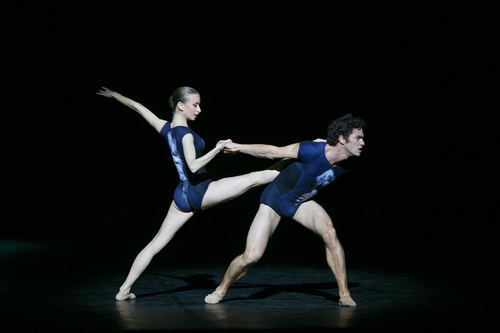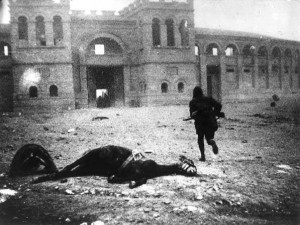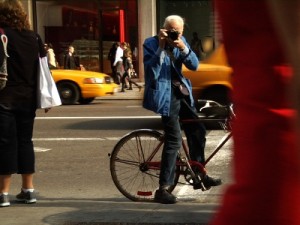
“La Danse—The Paris Opera Ballet,” 2009. Directed by Frederick Wiseman.
Though it’s been a particularly busy past few weeks here at Art21 production HQ – creating new exclusive videos, shooting the preparation and rehearsals for William Kentridge’s Nose production at the Metropolitan Opera, and in general getting ready for our next season – this has also been quite a fertile time for documentary screenings. So I thought I’d extend my last post and talk about some more hard-to-resist documentary offerings in New York City and beyond.
But first, in my last post, I mentioned the passing of the acclaimed documentary editor Karen Schmeer. One of the very hopeful things to come out of this very, very sad event is the establishment of the Karen Schmeer Editing Fellowship. Here’s the description in the words of the website:
“The Karen Schmeer Editing Fellowship has been established to honor the memory and spirit of Karen. The yearlong experience encourages and champions the talent of an emerging editor. The fellowship provides opportunities to help cultivate an editor’s artistry and craft and to expand his or her professional and creative community.”
Now, on to the screenings. This programming can’t really be defined as art-related, though; the films are a little too important and interesting to pass up for editorial niceties. First, I really need to mention the yearlong screening series of the films of legendary and still active documentary filmmaker Frederick Wiseman at the Modern Museum of Art in New York. MoMA is showing all his films to date – a remarkable 39 works, including his latest project, Boxing Gym (2009) – through the end of the year. If you’re anywhere in the area, it behooves you to at least catch one. And if you’re interested in an almost encyclopedic depiction of the world on film, then take this probably once in a lifetime chance and see all of them (and if you do, I’d love to hear from you). Though I’m sad to report that classics like Titicut Follies (1967) – once banned by the Massachusetts Supreme Court – and High School (1968) have already shown, there’s still a lot of great screenings left. Next up is Juvenile Court (1973) on March 18. Go here for the schedule. And if you’re looking for a little help in navigating an admittedly intimidating body of work, check out filmmaker and avowed Wiseman fan Errol Morris’s amusingly alternative guide here.

Republican soldier, Plaza de Toros, in Teruel, east of Madrid. 1936-39. Photographer unknown.
Since I just saw it last Tuesday night, I definitely have to note it now: the New York-based documentary presenting organization Stranger Than Fiction (mentioned in last month’s post) screened Best of the Orphan Film Symposium, a collection of “lost” archival films — some so lost that they were essentially premiered. Here’s a better description from one of the co-presenters, the Orphan Film Symposium:
“What is an orphan film? Narrowly defined, it’s a motion picture abandoned by its owner or caretaker. More generally, the term refers to all manner of films outside of the commercial mainstream: public domain materials, home movies, outtakes, unreleased films, industrial and educational movies, independent documentaries, ethnographic films, newsreels, censored material, underground works, experimental pieces, silent-era productions, stock footage, found footage, medical films, kinescopes, small- and unusual-gauge films, amateur productions, surveillance footage, test reels, government films, advertisements, sponsored films, student works, and sundry other ephemeral pieces of celluloid (or paper or glass or tape or . . . ).”
The biggest treat of the evening was the world premiere of the recently rediscovered 20-minute, silent 35mm film, With the Abraham Lincoln Brigade (1937-38). Shot by the French photographer Henri Cartier-Bresson, the film is essentially a fund-raising ad for the famous troop of American volunteers fighting for the Spanish republican-loyalist side in the Spanish Civil War. Besides the beautiful portrait photography and the gorgeously weathered quality of the film itself, what was particularly fascinating was the live audio commentary that film researcher Juan Salas provided. Juan is the film scholar who recently discovered the 18-minute silent work in the collection of the Abraham Lincoln Brigade Archives at NYU’s Tamiment Library. He drew connections between the film and Bresson’s later well-known “humanist” photography, making the case that this film serves as an important bridge from his earlier, surrealist-influenced work; pointed out key historical players; and most interestingly, he marked the film’s varied and numerous historical inconsistencies (much of the action was unapologetically scripted and staged for Bresson’s camera).
I hope to post an interview with the Stranger than Fiction’s artistic director, Thom Powers, in a future column. And for anyone interested in a more immediate STF showing, the April 6 screening of And Everything is Going Fine, director Steven Soderbergh’s presentation of Spalding Gray’s “final monologue,” sounds like a winner.
Not to confuse you further, but the With the Abraham Lincoln Brigade screening was in turn co-presented by the Orphan Film Symposium, a biennial “gathering biennial gathering of archivists, scholars, preservationists, curators, collectors, and media artists devoted to saving, studying, and screening neglected moving images.” And as luck would have it, the latest biennial is coming up, April 7-10, at the School of the Visual Arts Theatre in New York City. Now the organizers strongly encourage you to register for the full symposium, but it sounds very possible that folks just interested in individual screenings can call ahead to confirm. Go here for the full programming.
The Symposium is really part of a much larger cultural reclamation project, involving big organizations like the National Film Preservation Foundation and much smaller ones, like the Baltimore-based Center for Home Movies. The Center for Home Movies is dedicated to the preservation of something that’s close to my heart, amateur home movies (the original user-submitted content), and the celebration of genre masterpieces in their national Home Movie Day screenings. They, too, co-presented Tuesday night at the Stranger Than Fiction screening – a moving 16mm documentary film, a father’s portrait of his developmentally disabled son, Think of Me First as a Person. Check here for more screenings across the country. And now that I’m on the topic of orphaned films, there’s a very vital screening series in Philadelphia area, run by the ever-energetic Jay Schwartz, called Secret Cinema. Click here for future screenings.
Now for something a little more conventionally art-related. I’d be remiss not to mention the 28th edition of FIFA, the Festival International Du Film Sur L’Art, in Montreal. This one-of-a-kind festival – one of the biggest annual showcases of art on film in the world – runs March 18-28. There’s way too many offerings to make any kind of intelligent recommendations, so I’m going to be selfish and suggest some Art21-related screenings: About Jenny Holzer (2009), a 10 years-in-the-making portrait of artist Jenny Holzer; James Turrell is one of several artists featured in Let There Be Light (2008); and a personal favorite – Art21’s Season 5 episode Transformation, featuring Yinka Shonibare MBE, Cindy Sherman, and Paul McCarthy – will screen on March 20 and 21. Art21’s series producer Eve Moros Ortega will be in attendance. Hopefully I can get Eve to say a little something about her festival experience for my next post.
(I’m getting near the end, I swear.) It’s that time of year again — MoMA’s and Film Society of Lincoln Center’s venerable New Films/New Directors series is almost upon us. The 39th edition runs March 24 – April 4, and stand out documentaries include Bill Cunningham New York, a portrait of the legendary New York Times photographer, and Laura Poitras’s very intriguing-sounding The Oath. Be the first on your block to see these films; I’m catching the press screening of the latter.

Bill Cunningham. Courtesy Film Society of Lincoln Center & MoMA.
OK, done for now. But in the future, you can look forward to a discussion of some of the more interesting examples from a new and evolving short format art doc genre, museum/arts organization-produced online videos, as well as an uncut video from an upcoming talk between Season Five artist Carrie Mae Weems and actor, comedian, and Dancing with the Stars eliminee, David Alan Greer.





Pingback: What’s Cookin at the Art21 Blog: A Weekly Index | Art21 Blog
Pingback: On Location: Dr. Doc | An Interview with Thom Powers | Art21 Blog